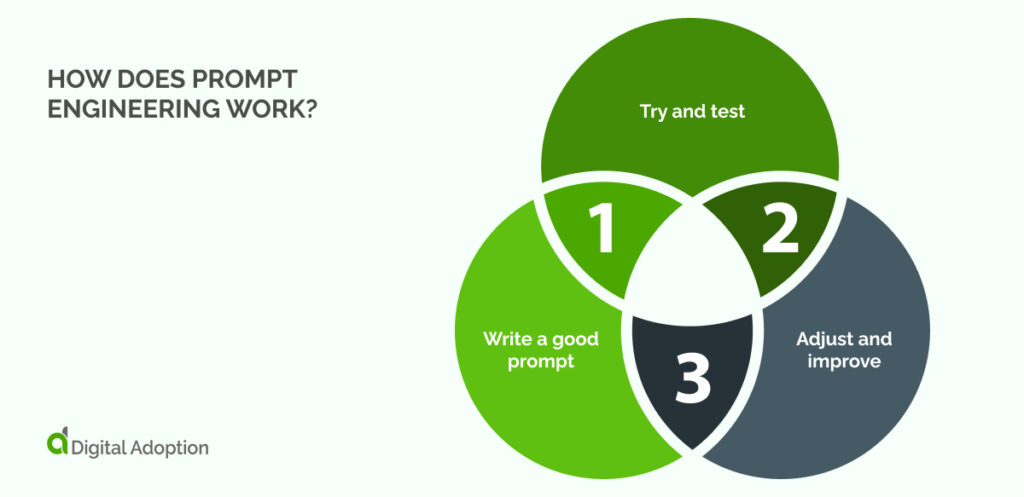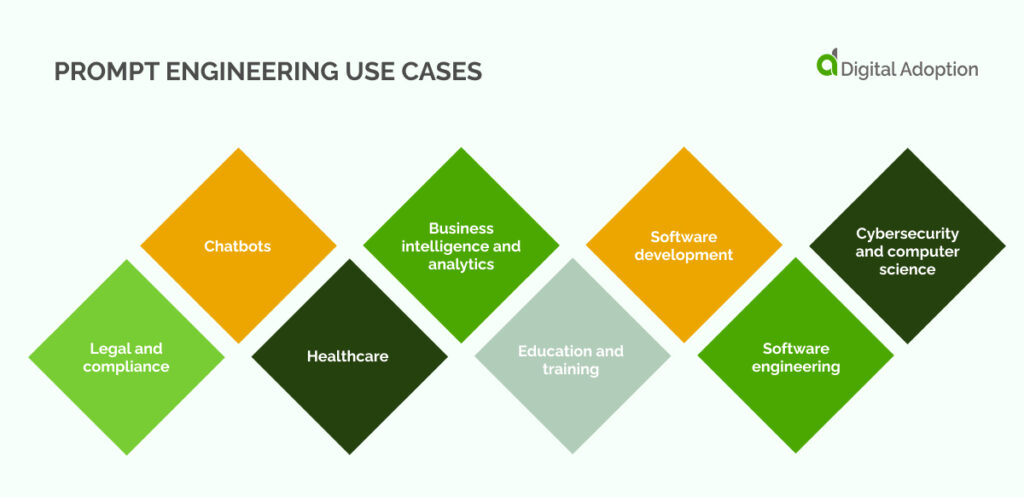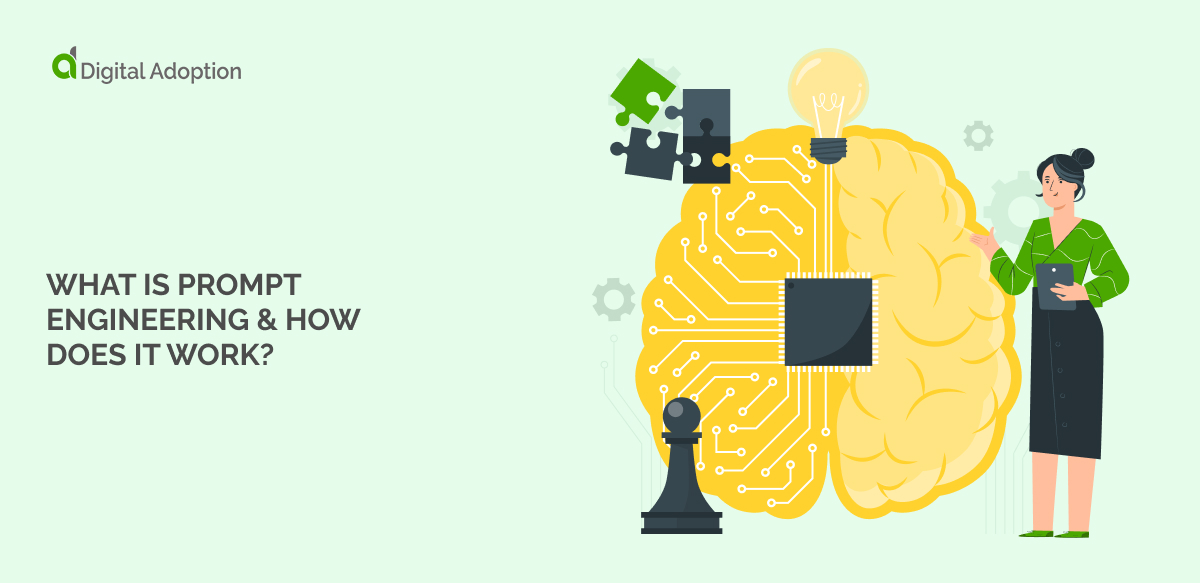Generative AI, powered by large language models (LLMs), is driving new tech advances.
These AI systems can create content, assist with choices, and find trends. They can act as digital helpers, doing tasks that usually need human input. They also spark creativity by making images, text, videos, and audio.
These systems use natural language understanding (NLU) and natural language processing (NLP) to learn and create outputs. However, their understanding is still limited.
This is where prompt engineering comes in. It makes results better by fine-tuning the questions given to AI. The models can be hard to predict, sometimes giving different or unhelpful answers to the same question.
This article will explore how AI boosts output and how prompt engineering makes answers more precise.
What is prompt engineering?
Prompt engineering is the process of designing and refining prompts to improve the responses of generative AI and large language models (LLMs). It aims to enhance response outputs by optimizing and improving prompt inputs.
Prompt engineering involves designing and refining input instructions to guide artificial intelligence systems in accurately understanding and interpreting user queries.
This field optimizes how AI systems, particularly language models, process and respond to inputs through techniques that enhance contextual comprehension and logical reasoning.
Effective prompts ensure that AI systems generate relevant and precise outputs, improving their overall performance and reliability.
These methods help the AI give answers that make sense, are reliable, and stay on topic.
Why is prompt engineering important?
Many businesses use prompt engineering to work faster and better.
A study by Grand View Research shows the prompt engineering market was worth $222.1 million in 2023. It’s expected to grow by 32.8% from 2024 to 2030.
As more companies use AI, it’s crucial to make sure AI gives clear, correct answers through smart questioning. We don’t know all the long-term effects of AI yet. This makes it even more vital to check if these tools are reliable.
AI can sometimes create false info, make things up, or state wrong facts. This can happen due to poor training, biased data, or flaws in what it learns.
Prompt engineering helps fix these issues. Better inputs and guiding AI to follow logical steps lead to more precise and focused outputs.
Companies must avoid AI risks that could slow progress. If not managed, these risks can lead to AI spreading lies, creating unfair content, or making bad choices.
Firms must be careful when making and using AI. If not, they risk their good name and might break regulations. Prompt engineering is one way to dodge these problems and keep AI growth ethical and accurate.
This method makes AI outputs more targeted and cuts down on mix-ups.
How does prompt engineering work?

Prompt engineering uses natural language skills to help AI grasp and follow instructions.
These models use various methods to solve problems, do tasks, and generate different types of content. These methods include machine learning (ML), deep learning (DL), and natural language processing (NLP).
Despite these combined powers, LLMs often struggle with context and nuance, leading to a range of possible outputs.
To tackle this challenge, prompt engineers create libraries of templates containing instructional, conversational, and creative scripts. They test and refine various prompt formats, optimizing the model’s understanding of complex instructions.
Let’s take a closer look at how prompt engineering works:
- Write a good prompt
Create clear, easy-to-understand prompts for AI tools. Avoid complex words unless they’re needed. Make the AI take on a specific role to get better answers and set clear limits to guide the AI’s response.
For example, ask it to describe something in three sentences. Don’t use questions that push for a certain answer. This helps get fair responses from the AI and Keep your prompts simple. You must learn how to fine-tune AI models like GPT-3 to improve at prompting.
These can teach you useful skills for working with different AI tools. Remember, a good prompt is key to getting the results you want from AI.
- Try and test
Making better prompts takes practice. Start by writing your first prompt based on your need, then use the AI to get an answer.
Check if the answer matches what you wanted. If not, change the prompt and try again. Keep doing this until you’re happy with the result. While you do this, try your prompt with different inputs, which helps make sure it works well in many situations.
Testing is a key part of making good prompts. It helps you understand how the AI thinks and how to guide it better. Don’t be afraid to try new ideas and see what works best.
- Adjust and improve
You can do more than just change the prompt. You can also adjust the AI model itself. This means changing the model’s settings to work better for specific tasks.
It’s a more complex method, but it can improve the AI’s performance for special uses. This process is called fine-tuning or calibrating the model. It allows you to tailor the AI to your needs.
To get better at writing prompts, try to understand how (LLMs) work. This can help you write prompts that get the answers you want. You can experiment with different ways to write prompts to see what works best.
Prompt engineering use cases

Understanding the different use cases of prompt engineering helps effectively apply AI across various tasks and industries.
Let’s take a closer look:
Legal and compliance
Prompt engineering in law and AI compliance improves document review, contract analysis, and rule checks. Better prompts help AI find key legal terms and spot compliance risks. AI can also handle routine tasks.
Lawyers can then focus on complex choices while AI manages repetitive work. Testing different prompts ensures compliance across regions. Adapting prompts to local laws makes the tool more reliable for legal tasks.
Chatbots
Prompt engineering makes chatbots and digital assistants more natural and aware of context.
Custom prompts help chatbots better grasp and answer tricky user questions, making customers happier. This tech works in many fields—from shops handling buyer queries to healthcare aiding patient talks.
By fine-tuning prompts, chatbots become smarter and able to give correct info, solve issues faster, and offer personal service. This makes them key in customer care across many areas.
Healthcare
In healthcare, prompt engineering boosts AI use for patient diagnosis, treatment advice, and office tasks.
Well-made prompts ensure AI systems read complex medical data correctly, aiding in faster diagnosis and custom treatments. They also smooth patient talks, like booking visits or managing follow-ups, making work more efficient.
In remote care, prompt engineering helps refine virtual visits, ensuring patient questions are understood and answered well, leading to better health results.
Business intelligence and analytics
Prompt engineering is essential in business insights by making data queries more precise. Custom prompts let AI systems pull useful insights from big data sets, aiding decision-making.
This helps in real-time analysis, where firms rely on precise, prompt-driven AI models to predict trends, track performance, and find chances.
Better prompts ensure AI tools give relevant, timely, and fitting insights. This approach drives strategic business plans and helps stay ahead of rivals.
Education and training
In education, prompt engineering refines AI tools for personal learning and effective training.
Custom prompts let AI adapt to each learner’s style, giving tailored content and feedback that boosts student interest and understanding.
For job training, prompt engineering helps create adaptive modules that respond to worker performance in real-time.
This leads to faster skill growth and better knowledge retention, making learning and training more dynamic and responsive to each person’s needs.
Software development
Prompt engineering is vital in software creation. It helps automate coding tasks and improve design processes. Well-crafted prompts help AI systems write code snippets, fix software, and suggest improvements.
This cuts down on time spent on routine tasks. As a result, development gets faster, and code quality gets better. Prompt engineering also aids software testing by guiding AI to find potential bugs or weak spots.
It ensures the final product is strong and secure. Prompt engineering helps teams streamline work and boost software performance.
Software engineering
Prompt engineering in software engineering refines AI tools for system design, analysis, and optimization tasks.
Precise prompts help AI systems grasp complex engineering needs and create optimal designs or solutions. This helps in big projects where efficiency and precision are key.
Automating routine tasks with prompt engineering lets engineers focus on new ideas and strategic growth. This improves overall project outcomes and reduces errors in the engineering process.
Cybersecurity and computer science
Prompt engineering in cybersecurity boosts threat detection, response, and system weakness analysis.
Better prompts enable AI systems to spot and stop potential security threats more accurately, ensuring strong protection against cyber-attacks.
In computer science, prompt engineering improves algorithm performance and optimizes computer processes.
It enables AI models to adapt to new threats and tech advances, making them more effective in protecting digital assets and advancing computer research.
This leads to safer, more efficient, innovative solutions in both fields.
Fine-tuning AI through prompt engineering
Prompt engineering is key in developing AI systems that give precise and reliable results.
Crafting targeted prompts helps AI grasp context, process data well, and produce outputs that match specific business goals. This precision is crucial for ensuring AI’s practical use across various sectors.
Creating explainable AI should be a priority as it becomes more common in businesses. Transparency in AI decision-making is essential, especially as these models become key to business operations. Prompt engineering must set clear system rules, ensuring AI follows logical reasoning and clear processes.
Companies need to refine and customize AI solutions to meet their specific needs. Generic, one-size-fits-all tools can hinder innovation and lead to inefficiency. A tailored approach ensures AI drives meaningful business outcomes.
Adopting a step-by-step approach in prompt engineering, with ongoing testing, allows businesses to refine AI systems.
FAQs
- Is prompt engineering a real job?
Yes, prompt engineering is a real job. It focuses on crafting and refining prompts to improve AI model responses. This role is critical in maximizing the effectiveness of AI systems, particularly with advanced models like GPT.
- What is prompt engineering salary?
The estimated annual total compensation for a Prompt Engineer AI is ₹9,79,006. The average base salary is ₹7,00,500 per year. These figures represent the median, calculated from Glassdoor’s proprietary Total Pay Estimate model.
- Is prompt engineering difficult?
Prompt engineering can be challenging, as it requires a deep understanding of AI models and the ability to craft precise instructions to achieve desired results. It involves continuous experimentation, problem-solving, and creativity to fine-tune prompts.








![18 Examples of AI in Finance [2025]](https://www.digital-adoption.com/wp-content/uploads/2025/06/18-Examples-of-AI-in-Finance-2025-300x146.jpg)




